Characteristics and Mechanism of the Environmental Capacity Changes in Haizhou Bay, Northern Jiangsu, China from 2006 to 2016
Abstract
1. Introduction
2. Materials and Methods
2.1. Overview of Haizhou Bay
2.2. Data Sources and Analytical Method
2.3. Research Methods
2.3.1. The Box Model Method
2.3.2. Determination of the Calculation Boundary
2.3.3. Calculation of Marine Environmental Capacity
Static Environmental Capacity (ECS)
Dynamic Environmental Capacity (ECD)
2.3.4. Numerical Simulation Method
Model Grid and Parameter Setting
Model Validation
Flow Field Diagram
2.3.5. The Influencing Factors and Changes of Bay Environmental Capacity
3. Results
3.1. Changes in Natural Conditions
3.2. ECG Calculation Results for 2006 and 2016
3.3. Calculation Results for the Hypothetical Scenarios
4. Discussion
4.1. Practical ECG Change Between 2006 and 2016
4.2. ECG-Influencing Factors and Ratios
5. Conclusions
Author Contributions
Funding
Conflicts of Interest
References
- Heuvel, T.; Hillen, R.H. Coastline management with GIS in the Netherlands. Adv. Remote Sens. 1995, 4, 27–34. [Google Scholar]
- Muller, J.R.M.; Chan, Y.-C.; Piersma, T.; Chen, Y.-P.; Aarninkhof, S.G.J.; Hassell, C.J.; Tao, J.-F.; Gong, Z.; Wang, Z.B.; Van Maren, D.S. Building for Nature: Preserving Threatened Bird Habitat in Port Design. Water 2020, 12, 2134. [Google Scholar] [CrossRef]
- Yu, C.Y.; Liang, B.; Han, G.C.; Huo, C.L.; Zhang, Z.F.; Ma, M.H. Discussion on the procedure and method of Marine oil spill ecological damage assessment. Ocean Dev. Manag. 2015, 32, 92–96. [Google Scholar] [CrossRef]
- Pérez, P.; Fernández, E.; Beiras, R. Fuel toxicity on Isochrysis galbana and a coastal phytoplankton assemblage: Growth rate vs. variable fluorescence. Ecotoxicol. Environ. Saf. 2010, 73, 254–261. [Google Scholar] [CrossRef] [PubMed]
- O’Driscoll, M.; Clinton, S.; Jefferson, A.; Manda, A.; McMillan, S. Urbanization Effects on Watershed Hydrology and In-Stream Processes in the Southern United States. Water 2010, 2, 605–648. [Google Scholar] [CrossRef]
- Dong, Z.; Kuang, C.; Gu, J.; Zou, Q.; Zhang, J.; Liu, H.; Zhu, L. Total Maximum Allocated Load of Chemical Oxygen Demand Near Qinhuangdao in Bohai Sea: Model and Field Observations. Water 2020, 12, 1141. [Google Scholar] [CrossRef]
- Yang, J.W. Theory and Practice of Conducting Total-Quantity Control of Pollutants Discharge in the Near shore Sea Area. Mar. Inf. 2001, 24–26. [Google Scholar] [CrossRef]
- Pravdić, V.; Juračić, M. The environmental capacity approach to the control of marine pollution: The case of copper in the Krka River Estuary. Chem. Ecol. 1988, 3, 105–117. [Google Scholar] [CrossRef]
- Krom, M.D.; Hornung, H.; Cohen, Y. Determination of the environmental capacity of Haifa Bay with respect to the input of mercury. Mar. Pollut. Bull. 1990, 21, 349–354. [Google Scholar] [CrossRef]
- Trela, J.; Płaza, E. Innovative technologies in municipal wastewater treatment plants in Sweden to improve Baltic Sea water quality. E3S Web Conf. 2018, 45, 113. [Google Scholar] [CrossRef]
- Malcangio, D.; Melena, A.; Damiani, L.; Mali, M.; Saponieri, A. Numerical Study of Water Quality Improvement in a Port through a Forced Mixing System. In Water Resources Management IX; WIT Press: Southampton, UK, 2017; pp. 69–80. [Google Scholar]
- Mali, M.; Ungaro, N.; Cardellicchio, A.; Dell’Anna, M.M.; Romanazzi, G.; Mastrorilli, P.; Damiani, L. Long-term monitoring programs to assess environmental pressures on coastal area: Weighted indexes and statistical elaboration as handy tools for decision-makers. Ecol. Indic. 2019, 101, 838–850. [Google Scholar] [CrossRef]
- Zhang, W.L.; Liu, H.; Feng, J.F.; Zhu, L.; Liu, Y.; Ma, Z.H. Research on the Total Dissolved Inorganic Nitrogen Flux into the Bohai Bay. Environ. Monit. Chi. 2015, 31, 41–44. [Google Scholar] [CrossRef]
- Yu, Y.; Peng, C.S.; Yu, L.L.; Gu, Q.B.; Chang, J.M. Environmental capacity calculation of petroleum hydrocarbons in Laizhou Bay—The discharge optimization method based on the nonlinear programming. Mar. Environ. Sci. 2014, 33, 293–299. [Google Scholar] [CrossRef]
- Long, Y.X.; Chen, J.; Han, B.X. Research on Marine Environmental Capacity in the Beibu Gulf Economic Zone. Acta Sci. Nat. Univ. Sunyatseni 2014, 53, 83–88. [Google Scholar] [CrossRef]
- Zhang, X.Q.; Sun, Y.L. study on the environmental capacity in Jiaozhou Bay. Mar. Environ. Sci. 2007, 26, 347–350+359. [Google Scholar]
- Ge, S.F. Study on Water Environmental Capacity of Liaohe River in Jilin Province. Ph.D. Thesis, Jilin University, Changchun, China, 2012. [Google Scholar]
- Wang, W.P. Study on Simulation of the Water Environmental Capacity Change and Controlling Measures of the Total Amount Pollutants Discharge in Jiulong River Watershed. Ph.D. Thesis, Xiamen University, Xiamen, China, 2007. [Google Scholar]
- Ma, X.X.; Li, C.Y.; Shi, X.H.; Zhao, S.N.; Sun, B.; Zhu, Y.H. Environment Capacity of the Wuliangsuhai Lake. J. Irrig. Drain. 2019, 38, 105–112. [Google Scholar] [CrossRef]
- Ou, M.L. Study on Impact of Three Gorges Reservoir Operation on Variation Characteristics of Nitrogen and Phosphorus in Waters of Poyang Lake. Master’s Thesis, East China University of Technology, Nanchang, China, 2012. [Google Scholar]
- Sun, X.M.; Zhang, C.Z.; Shen, X.W. Total amount control of pollutant discharged into sea area around Changxingdao Island. Mar. Environ. Sci. 2009, 28, 399–402. [Google Scholar] [CrossRef]
- Tang, J.Y. Research of Volume Control and Emission Reduction of COD, Nitrogen, Phosphorus in Water of Pulandian Bay. Master’s Thesis, Dalian Maritime University, Dalian, China, 2016. [Google Scholar]
- Jiang, H.Z.; Cui, L.; Yu, D.T.; Gao, F.; Wu, L.G. Study on sea area Environmental capacity of Majiazui sewage Outlet on Changxing Island in Dalian. J. Appl. Oceanogr. 2017, 36, 202–209. [Google Scholar] [CrossRef]
- Chen, Y. Environmental Capacity and Total Quantity Control of Nitrogen and Phosphorus in the Northern Part of Liaodong Bay. Master’s Thesis, Shanghai Ocean University, Shanghai, China, 2017. [Google Scholar]
- Lin, L.; Liu, D.Y.; Liu, Z.; Gao, H.W. Impact of land reclamation on marine hydrodynamic and ecological environment. Haiyang Xuebao 2016, 38, 1–11. [Google Scholar] [CrossRef]
- Lan, D.D.; Liang, B.; Ma, M.H.; Yu, C.Y.; Bao, C.G.; Xu, Y. Application of Marine environmental capacity analysis in planning environmental impact assessment. Ocean Dev. Manag. 2013, 30, 62–65. [Google Scholar] [CrossRef]
- Wang, C.Y.; Wang, X.L.; Li, K.Q.; Liang, S.K.; Su, R.G.; Yang, S.P. The estimation of copper, lead, zinc and cadmium fluxes into the sea area of the East China Sea interferenced by terrigenous matter and their environmental capacities. Acta Oceanol. Sin. 2010, 32, 62–76. [Google Scholar] [CrossRef]
- Lucea, A.; Duarte, C.M. Nutrient (N, P and Si) and carbon partitioning in the stratified NW Mediterranean. J. Sea Res. 2003, 49, 157–170. [Google Scholar] [CrossRef]
- Dafner, E.V.; Mallin, M.A.; Souza, J.J.; Wells, H.A.; Parsons, D.C. Nitrogen and phosphorus species in the coastal and shelf waters of Southeastern North Carolina, Mid-Atlantic U.S. coast. Mar. Chem. 2007, 103. [Google Scholar] [CrossRef]
- Sunda, W. The relationship between cupric ion activity and the toxicity of copper to phytoplankton. J. Mar. Res. 1975. [Google Scholar] [CrossRef]
- Myers, R.A.; MacKenzie, B.R.; Bowen, K.G. What is the carrying capacity for fish in the ocean? A meta-analysis of population dynamics of North Atlantic cod. Can. J. Fish. Aquat. Sci. 2001, 58, 1464–1476. [Google Scholar] [CrossRef]
- Stebbing, A.R.D. Environmental capacity and the precautionary principle. Mar. Pollut. Bull. 1992, 24, 287–295. [Google Scholar] [CrossRef]
- Tedeschi, S. Assessment of the environmental capacity of enclosed coastal sea. Mar. Pollut. Bull. 1991, 23, 449–455. [Google Scholar] [CrossRef]
- Guo, L.B.; Jiang, W.S.; Li, F.Q.; Wang, X.L. Environmental Capacity Calculation of COD and PHs in the Bohai Sea. Period. Ocean Univ. Chi. 2007, 37, 310–316. [Google Scholar] [CrossRef]
- Zhu, J.; Wang, J.F.; Tian, Z.F.; Chen, Y.X. Marine environment capacity research progress and calculation methods. Water Sci. Eng. Technol. 2009, 8–11. [Google Scholar] [CrossRef]
- Putzu, S.; Enrile, F.; Besio, G.; Cucco, A.; Cutroneo, L.; Capello, M.; Stocchino, A. A Reasoned Comparison between Two Hydrodynamic Models: Delft3D-Flow and ROMS (Regional Oceanic Modelling System). J. Mar. Sci. Eng. 2019, 7, 464. [Google Scholar] [CrossRef]
- Garcia, M.; Ramirez, I.; Verlaan, M.; Castillo, J. Application of a three-dimensional hydrodynamic model for San Quintin Bay, B.C., Mexico. Validation and calibration using OpenDA. J. Comput. Appl. Math. 2015, 273, 428–437. [Google Scholar] [CrossRef]
- Rueda-Bayona, J.G.; Osorio, A.F.; Guzman, A. Set-up and input dataset files of the Delft3d model for hydrodynamic modelling considering wind, waves, tides and currents through multidomain grids. Data Brief 2020, 28, 104921. [Google Scholar] [CrossRef]
- Dai, P.; Zhang, J.-S.; Zheng, J.-H.; Hulsbergen, K.; Van Banning, G.; Adema, J.; Tang, Z.-X. Numerical study of hydrodynamic mechanism of dynamic tidal power. Water Sci. Eng. 2018, 11, 220–228. [Google Scholar] [CrossRef]
- Sun, L.; Wang, J.; Zhang, H.; Xu, M. The Characteristics and Mechanism of Changes in the Marine Environmental Capacity of the Estuaries of Haizhou Bay in Northern Jiangsu from 2006 to 2016. J. Mar. Sci. Eng. 2020, 8, 787. [Google Scholar] [CrossRef]
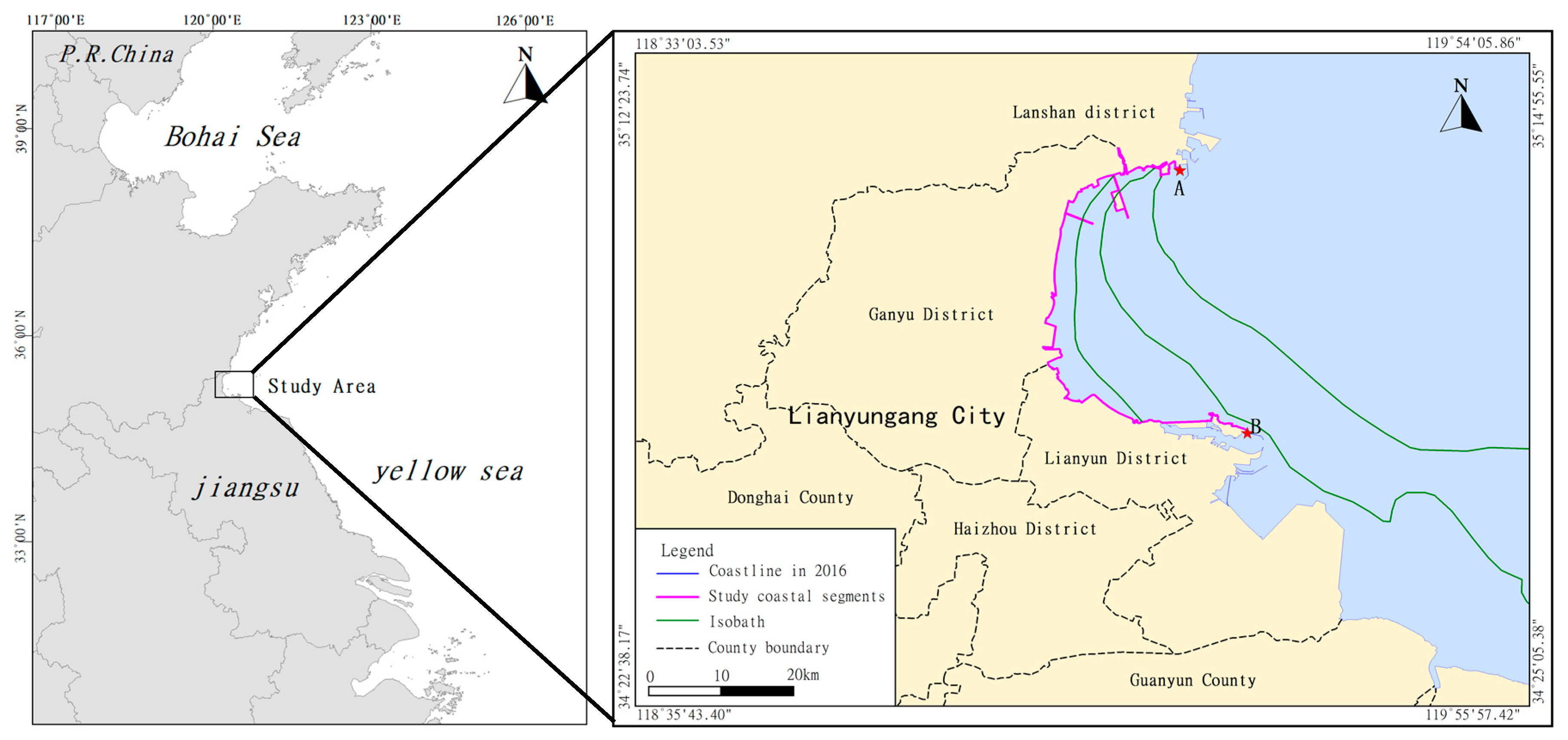

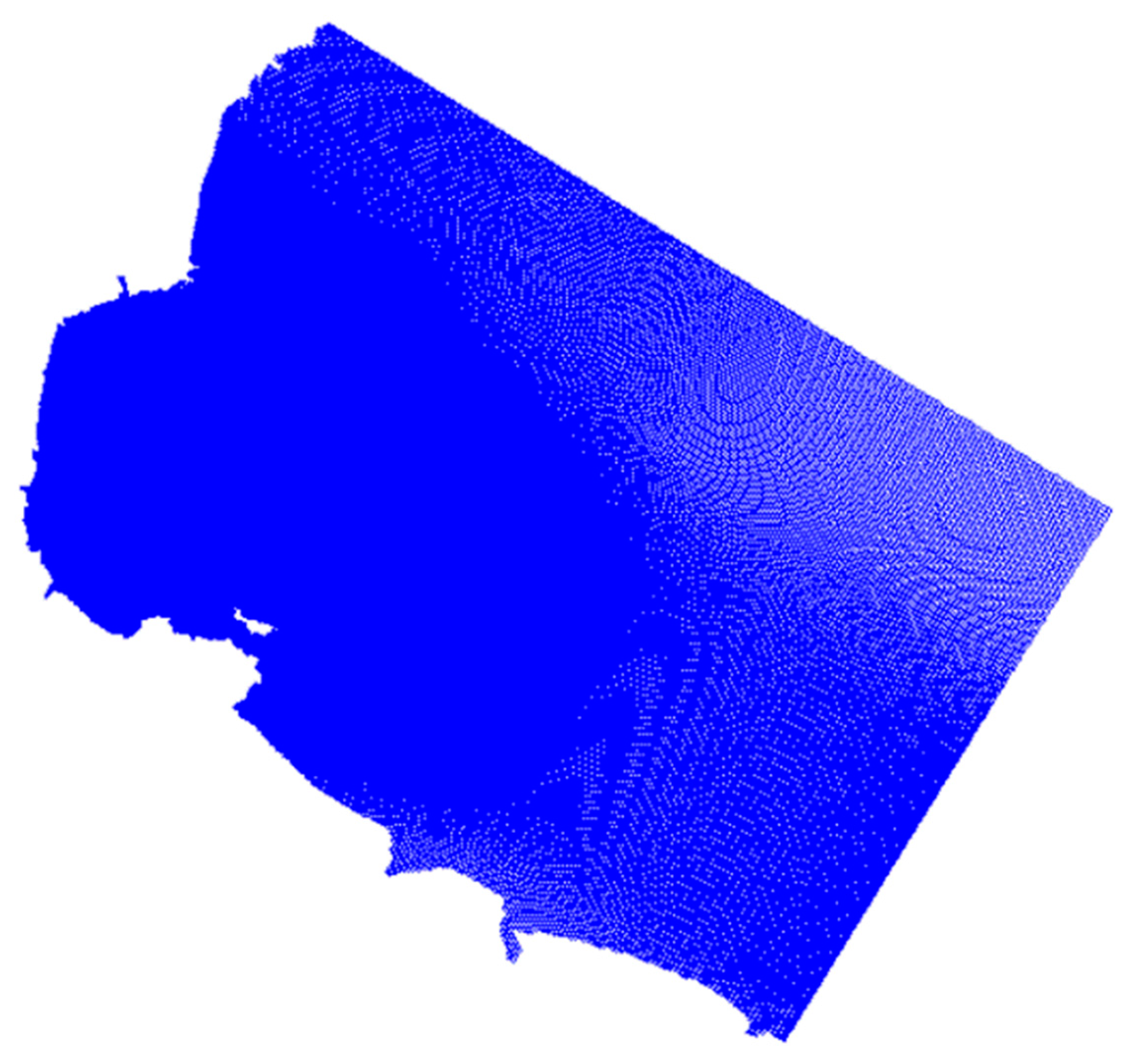

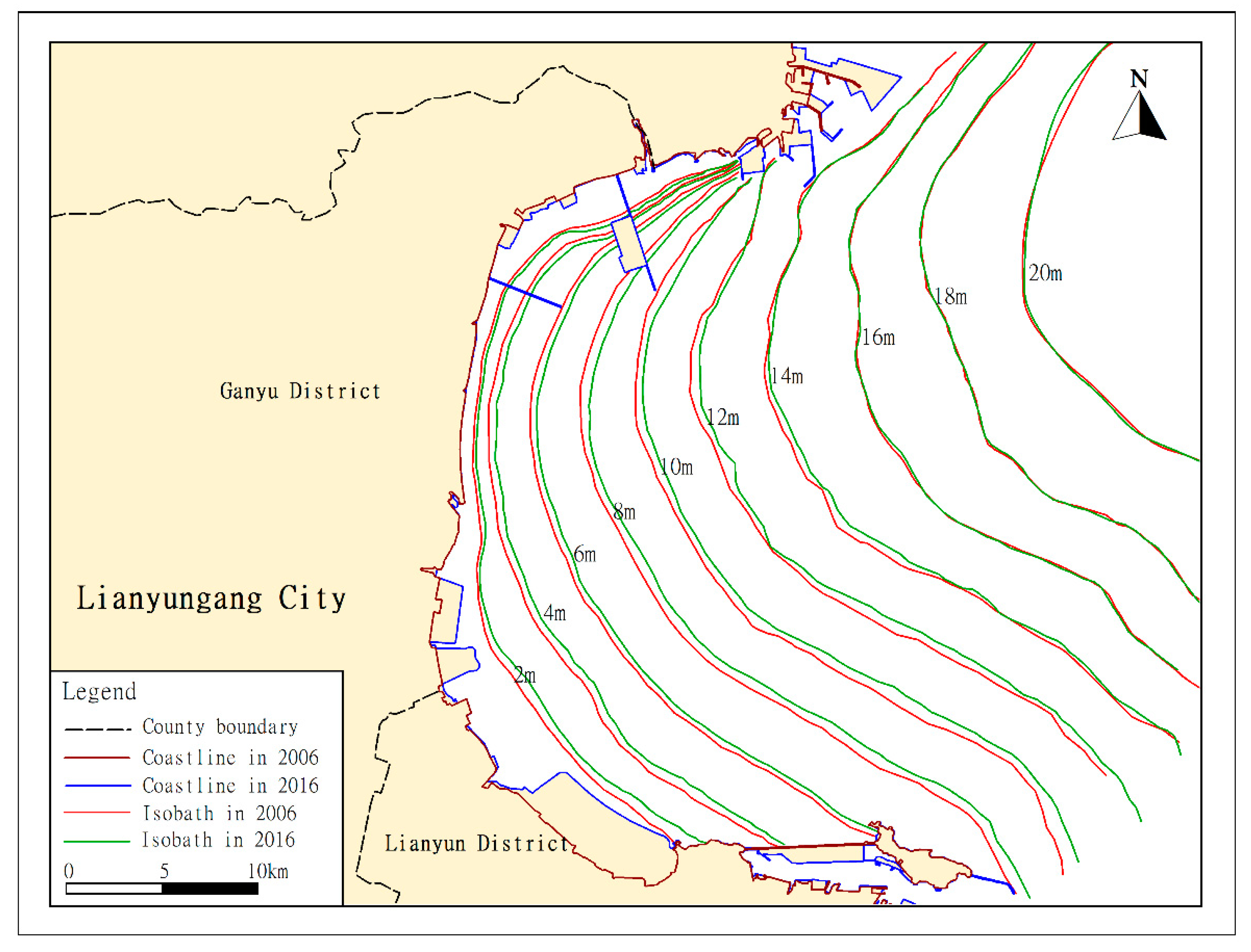
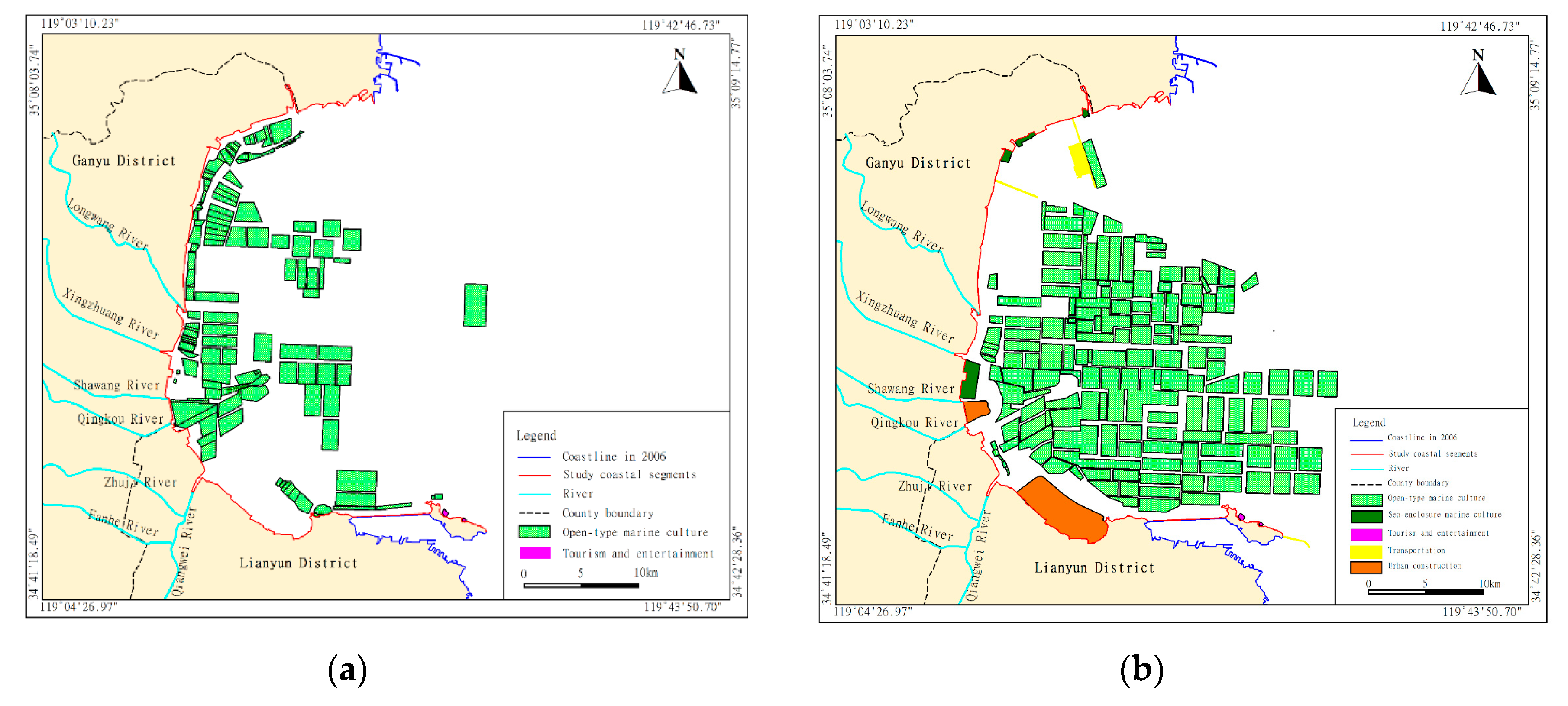
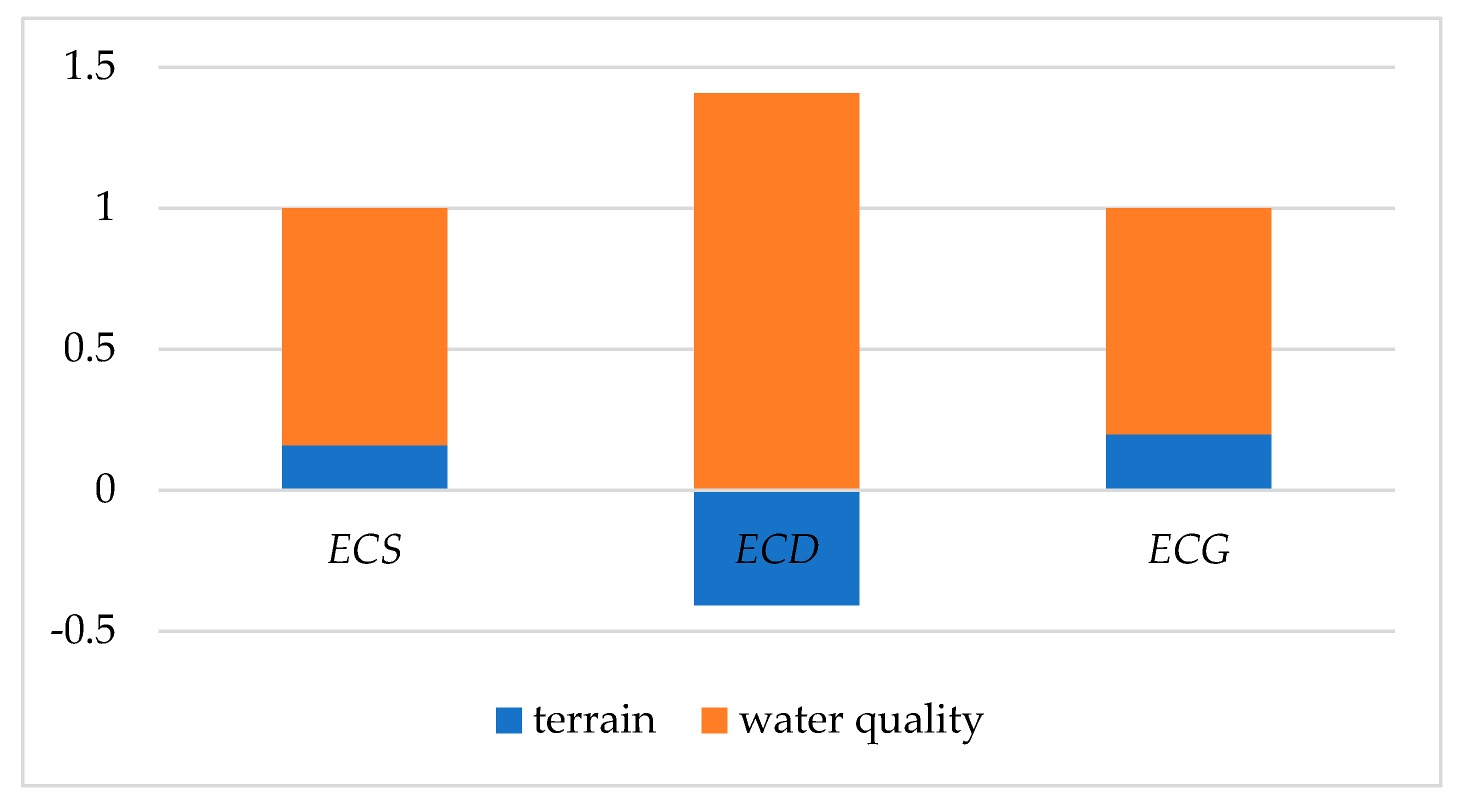
| Chemical Oxygen Demand (mg/L) | Labile Phosphate (mg/L) | Inorganic Nitrogen (mg/L) | |
|---|---|---|---|
| 2006 | 1.39 | 0.0078 | 0.084 |
| 2016 | 1.62 | 0.02 | 0.31 |
| second-class water quality standards | 3 | 0.03 | 0.3 |
| Item | Parameter | Definition | Unit | Source or Equation | 2006 | 2016 | 2016–2006 |
|---|---|---|---|---|---|---|---|
| Parameter | Cb | The standard water quality of marine functional zoning | mg/L | It should meet the second-class standards stipulated in the Sea Water Quality Standard | 3 | 3 | 0 |
| Cx | The present pollutant concentration inside Haizhou Bay | mg/L | Current Condition and Assessment of Trend of Water Quality in Offshore Water of the Haizhou Bay (2006); Report on offshore environmental quality of Lianyungang of Jiangsu Province, 2016 | 1.39 | 1.63 | 0.24 | |
| Cw | The present pollutant concentration outside Haizhou Bay | mg/L | Current Condition and Assessment of Trend of Water Quality in Offshore Water of the Haizhou Bay (2006); Report on offshore environmental quality of Lianyungang of Jiangsu Province, 2016 | 1.205 | 1.40 | 0.195 | |
| S | The sea area enclosed by the box boundary | million m3 | ArcGIS was used for calculation based on the coastline and boundary of 2006 and 2016 | 101.034 | 97.541 | −3.493 | |
| L | The mean depth of seawater in the box | m | Topographic maps were used | 10.367 | 10.413 | 0.046 | |
| Vx | The water body volume in the box | million m3 | Vx = S × L | 10.474 | 10.157 | −0.317 | |
| Vn | The mean exchanged water body volume of Haizhou Bay | billion m3 | Delft 3D was used based on the boundary of 2006 and 2016 to calculate the daily mean exchanged water body volume of spring and neap tides | 5.91825 | 5.5575 | −0.36075 | |
| ECG | ECSb | The maximum ECG of Haizhou Bay in theory in the standard water quality | tons | ECSb = Cb × Vx | 31,422.58 | 30,470.83 | −951.75 |
| ECSd | The used ECG in the background condition | tons | ECSb = Cx × Vx | 14,559.13 | 16,555.82 | 1996.69 | |
| ECDx | Theoretical maximum dynamic environmental capacity | tons | ECDx = Cb × Vn | 17,754.75 | 16,672.50 | −1082.25 | |
| ECS | The static environmental capacity | tons | ECS = ECSb − ECSd | 16,863.45 | 13,915.0 | −2948.44 | |
| ECD | The dynamic environmental capacity | tons | ECD = (Cx − Cw) × Vn | 1094.88 | 1278.23 | 183.35 | |
| ECG | The environmental capacity of the gulf | tons | ECG = ECS + ECG | 17,958.33 | 15,193.25 | −2765.08 |
| ECSb | ECDx | ECS | ECD | ECG | |
|---|---|---|---|---|---|
| Scenario A (2006 terrain + 2016 water quality) | 31,422.58 | 17,754.75 | 14,349.65 | 1361.20 | 15,710.85 |
| Scenario B (2016 terrain + 2006 water quality): | 30,470.83 | 16,672.50 | 16,352.68 | 1028.14 | 17,380.82 |
| ECS | ECD | ECG | |
|---|---|---|---|
| 2016–2006 | −2948.44 | 183.35 | −2765.08 |
| 1#-1 Scenario B—2006 (terrain) | −510.77 | −66.74 | −577.51 |
| 1#-2 2016—Scenario B (water quality) | −2437.67 | 250.09 | −2187.57 |
| (1#-1) + (1#-2) | −2948.44 | 183.35 | −2765.08 |
| Influencing ratio (terrain/water quality) | 0.173:0.827 | −0.364:1.364 | 0.209:0.791 |
| 2#-1 Scenario A—2006 (water quality) | −2513.8 | 266.32 | −2247.48 |
| 2#-2 2016—Scenario A (terrain) | −434.64 | −82.97 | −517.6 |
| (2#-1) + (2#-2) | −2948.44 | 183.35 | −2765.08 |
| Influencing ratio (terrain/water quality) | 0.147:0.853 | −0.453:1.453 | 0.187:0.813 |
| Overall influencing ratio (terrain/water quality) | 0.16:0.84 | −0.408:1.408 | 0.198:0.802 |
Publisher’s Note: MDPI stays neutral with regard to jurisdictional claims in published maps and institutional affiliations. |
© 2020 by the authors. Licensee MDPI, Basel, Switzerland. This article is an open access article distributed under the terms and conditions of the Creative Commons Attribution (CC BY) license (http://creativecommons.org/licenses/by/4.0/).
Share and Cite
Sun, L.; Wang, J.; Zhang, H.; Xu, M. Characteristics and Mechanism of the Environmental Capacity Changes in Haizhou Bay, Northern Jiangsu, China from 2006 to 2016. Water 2020, 12, 2990. https://doi.org/10.3390/w12112990
Sun L, Wang J, Zhang H, Xu M. Characteristics and Mechanism of the Environmental Capacity Changes in Haizhou Bay, Northern Jiangsu, China from 2006 to 2016. Water. 2020; 12(11):2990. https://doi.org/10.3390/w12112990
Chicago/Turabian StyleSun, Lei, Jing Wang, Haifeng Zhang, and Min Xu. 2020. "Characteristics and Mechanism of the Environmental Capacity Changes in Haizhou Bay, Northern Jiangsu, China from 2006 to 2016" Water 12, no. 11: 2990. https://doi.org/10.3390/w12112990
APA StyleSun, L., Wang, J., Zhang, H., & Xu, M. (2020). Characteristics and Mechanism of the Environmental Capacity Changes in Haizhou Bay, Northern Jiangsu, China from 2006 to 2016. Water, 12(11), 2990. https://doi.org/10.3390/w12112990




